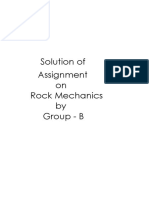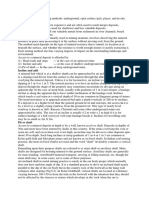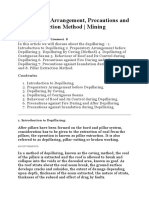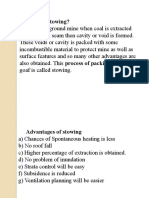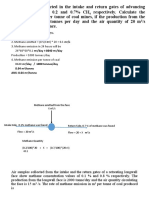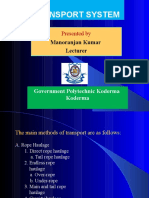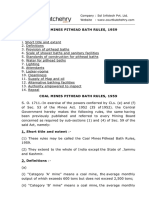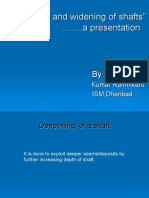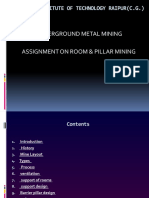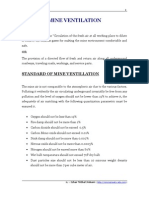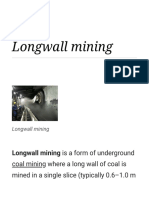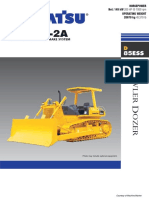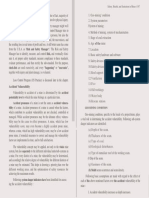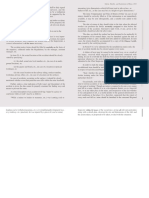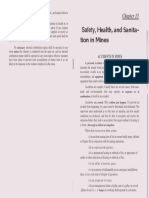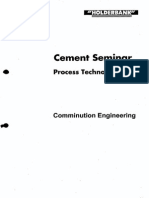Horizon Mining
Horizon Mining
Uploaded by
Vidya SagarCopyright:
Available Formats
Horizon Mining
Horizon Mining
Uploaded by
Vidya SagarOriginal Description:
Copyright
Available Formats
Share this document
Did you find this document useful?
Is this content inappropriate?
Copyright:
Available Formats
Horizon Mining
Horizon Mining
Uploaded by
Vidya SagarCopyright:
Available Formats
It's exactly what you think it is based on the (independent) meanings of the two words.
Horizon or horizontal mining can be applied to extraction of material from seams of any stratified mineral such as limestone or ironstone, but it is more usually associated with coal - particularly where there are several seams that are inclined or folded and/or faulted. Traditional methods of mining involved sinking a shaft to a seam and then following the undulations of the seam with underground roadways as the mineral is extracted. This in turn meant that the roadways following the working face followed the undulations of the seam making transport along them difficult. These roadways also required constant maintenance to counter the crushing effect of having been constructed through the area from which the mineral had been extracted. Horizon mining involves long level roadways (horizons) being driven from the shafts to the extremity of the area to be mined. The levels of the horizons are chosen to intersect the maximum number of seams the maximum number of times. As the seams are intersected, headings will be driven into the seam so that the desired material may be extracted. This method of mining requires a thorough understanding of the geological structure of the area to be mined so that the level of the horizons can be chosen for optimum results. This method of mining is popular in modern coal mines with seams worked from several horizons. The considerable capital outlay of driving horizons before production can begin is recouped by the advantage of having long straight level roadways of generous dimensions unaffected by the crushing effect of nearby extraction of the mineral. The mineral being mined will generally be carried by conveyor belt from the working face to a loading point at the appropriate horizon. Here the mineral will be loaded into a train of mine cars, each of several tonnes capacity. These trains, with a payload of several hundred tonnes, will then be hauled at high speed by electric or diesel (ventilation permitting) locomotives to the shaft bottom for transfer to cages for ascent of the shaft. In modern horizon mining, several horizons will be driven in the same direction from a vertical shaft. The horizons will, therefore, appear as a vertical stack of roadways which it is difficult to represent on a conventional mine plan. This being the case, it is usual to show the relative position of horizons on an isometric drawing for clarity. Underground connections between horizons can be made by staple shafts (entirly underground shafts) or inclined drifts. In modern coal mines, the workings are generally contained between two horizons with the vertical separation being dependent on the geological structure of the strata. The lower horizon would normally be used as the intake airway and the upper horizon used as the return airway. This takes advantage of the natural tendancy for the air, as it is heated by its passage around the mine, to rise to a higher level. It is standard practice for the intake airway, the lower horizon, to be used as the main haulage road as gravity will assist the coal on its journey from face to mine car.
Although horizon mining is widely held to have been developed in Germany in the early 20th century, its origins almost certainly date to the Duke of Bridgewater's coal mines at Worsley near Manchester. It was here in 1765 that a branch of the Bridgewater Canal was driven into the mine so that loaded boats could travel from the working face in the mine directly to Manchester, which was some 8 miles away - and without any double handling of the cargo. This caused the price of coal in Manchester to drop from (in modern units) 45p/tonne to 22p/tonne - a 50% reduction! The fundamental requirement for a canal to be level produced what amounted to the first mining horizon. The extent of the underground canals in the Worsley Mines amounted to 46 miles on three levels connected by underground locks and inclined planes. The boats used could carry about 10 tonnes each. The canal tunnel entrances to Worsley mines can still be seen. Underground access cannot be permitted because of the danger cave in and of explosive and toxic gases associated with coal mines. In the 1770's, the Earl of Dudley extended a branch of the Birmingham Canal into his limestone mines within Dudley Castle Hill. Various branches were driven from this tunnel to serve all parts of the Castle Hill Mines. The length of these underground canals were maximised by following the strike (contour) of the seams once they had been reached. In 1792 after a construction period of 8 years, the original tunnel was extended a distance of 3km to link with the Dudley & Stourbridge Canals. In 1841, it is recorded that this tunnel carried 41,000 boats. In 1805, the Earl of Dudley promoted another branch from what was now the Dudley Canal Tunnel. This tunnel was driven west for a distance of a little more than 1km to the developing limestone mines in Wrens Nest Hill. It terminated in two loading basins. Each was large enough to hold 12 narrow boats, and each boat had a capacity of 25 to 30 tonnes. In all, the network of underground canals within Dudley Castle Hill and Wrens Nest Hill can be considered to be on one horizon, being that they are all on the same level. This horizon intersects 2 beds of limestone 8 times. This can, therefore, be considered to be an excellent example of horizon mining long before the term came into common use. The underground canal system and limestone mines at Dudley, West Midlands, can be visited by contacting the Dudley Canal Trust on 01384 236275. A link to their web site is provided.
You might also like
- Cost Models of Theoretical Mining Operations - CostMine PDFDocument5 pagesCost Models of Theoretical Mining Operations - CostMine PDFVidya Sagar50% (2)
- Rock Mechanics Assignment by Group BDocument10 pagesRock Mechanics Assignment by Group BSmruti RanjanNo ratings yet
- Surface Subsidence Engineering: Theory and PracticeFrom EverandSurface Subsidence Engineering: Theory and PracticeSyd S. PengNo ratings yet
- Objective and Scope and Importance of Mineral Beneficiation With Special Reference To IndiaDocument4 pagesObjective and Scope and Importance of Mineral Beneficiation With Special Reference To IndiaVidya Sagar100% (3)
- Side View of Consumer DP Structure: 11Kv HG Fuse Set DetailsDocument1 pageSide View of Consumer DP Structure: 11Kv HG Fuse Set DetailsDevidas JaijarNo ratings yet
- Site Selection of An Incline or Pit:: R FurtherDocument6 pagesSite Selection of An Incline or Pit:: R FurtherSatyajeet ParidaNo ratings yet
- Mine DevelopmentDocument4 pagesMine DevelopmentsunilsinghmNo ratings yet
- Longwall Mining Is A Form of UndergroundDocument31 pagesLongwall Mining Is A Form of UndergroundNaniNo ratings yet
- CorrelationDocument14 pagesCorrelationAlekkhyya RoySENo ratings yet
- Metal Mining Stoping MethodsDocument51 pagesMetal Mining Stoping MethodsSheshu BabuNo ratings yet
- Diploma Mining III ToVIDocument45 pagesDiploma Mining III ToVIIrfanMarwanzaNo ratings yet
- Horizon Mining Level Mining: Longwall & Other Methods of WorkingDocument14 pagesHorizon Mining Level Mining: Longwall & Other Methods of WorkingVamshiNo ratings yet
- Basic Concepts of Surface Mining PDFDocument56 pagesBasic Concepts of Surface Mining PDFHarikrishnaNo ratings yet
- Longwall MiningDocument1 pageLongwall Miningsandro0112100% (2)
- Gate CompiledDocument145 pagesGate CompiledAjeet KumarNo ratings yet
- Vol 1 3drillingDocument12 pagesVol 1 3drillingVamshi100% (1)
- Depillaring With StowingDocument24 pagesDepillaring With Stowingmohit kumar [NIT Rourkela]No ratings yet
- Stowing What Is Stowing?Document19 pagesStowing What Is Stowing?Harsh Sahu100% (1)
- Chapter 4 Underground Coal MiningDocument58 pagesChapter 4 Underground Coal Miningrishav baishyaNo ratings yet
- Rope HaulageDocument17 pagesRope HaulageDinesh Kumar100% (1)
- Deisel Locomotive HaulageDocument9 pagesDeisel Locomotive HaulageAnurag TripathyNo ratings yet
- Methane Layering in MinesDocument5 pagesMethane Layering in MinesAnurag TripathyNo ratings yet
- Selecting Methods of Extraction of Steeply Dipping Coal SeamDocument24 pagesSelecting Methods of Extraction of Steeply Dipping Coal SeammanikantaNo ratings yet
- MM PracticalDocument5 pagesMM PracticalSilent TornadoNo ratings yet
- Important Legislation Section For Cil MT (Mining) Exam PDFDocument169 pagesImportant Legislation Section For Cil MT (Mining) Exam PDFSatyam Gupta0% (1)
- Thick Seam Mining Methods and Problems Associated With It: Submitted By: SAURABH SINGHDocument13 pagesThick Seam Mining Methods and Problems Associated With It: Submitted By: SAURABH SINGHPrabhu PrasadNo ratings yet
- GATE Mining Engineering PDFDocument2 pagesGATE Mining Engineering PDFSandeep SinghNo ratings yet
- Free-Samples - Amie - Chapters - Pillar Mining Methods-Sec-B-EmdDocument31 pagesFree-Samples - Amie - Chapters - Pillar Mining Methods-Sec-B-EmdSouvik RayNo ratings yet
- Ballu Minor Project Report 2Document30 pagesBallu Minor Project Report 2virendra behraNo ratings yet
- Assignment On Underground Metal MiningDocument38 pagesAssignment On Underground Metal MiningAnshul yadav0% (1)
- Mining Machinery IIDocument27 pagesMining Machinery IIManoranjan KumarNo ratings yet
- CP Wise Test - 1 (Mine Ventilation) 20.11.2019 QDocument6 pagesCP Wise Test - 1 (Mine Ventilation) 20.11.2019 QPranab Pradhan100% (1)
- Underground Mining Methods Choice of MethodsDocument8 pagesUnderground Mining Methods Choice of MethodsSheshu Babu100% (1)
- Room-And-pillar Method of Open Stope MiningDocument6 pagesRoom-And-pillar Method of Open Stope MiningIsmaelNo ratings yet
- Assignment 1 Rock MechanicsDocument2 pagesAssignment 1 Rock MechanicstkubvosNo ratings yet
- Pillar Design in Coal Mines.Document24 pagesPillar Design in Coal Mines.Waterdrop' 'Dew100% (1)
- Chap 1Document24 pagesChap 1Kunal KishorNo ratings yet
- DL Balancing DiagramDocument7 pagesDL Balancing DiagramJay Yadav100% (1)
- GATE Mining Engineering Solved 2012Document13 pagesGATE Mining Engineering Solved 2012rrathoreNo ratings yet
- Coal Mines Pithead Bath Rules, 1959Document5 pagesCoal Mines Pithead Bath Rules, 1959Swapan HalderNo ratings yet
- Midterm - Unit Operations, Surface Mining (Notes)Document9 pagesMidterm - Unit Operations, Surface Mining (Notes)Fabie BarcenalNo ratings yet
- 07 Underground Mine MechanisationDocument16 pages07 Underground Mine MechanisationNeha Sharma100% (2)
- 06MinE417 - Natural Ventilation PDFDocument11 pages06MinE417 - Natural Ventilation PDFalpgezer80% (5)
- Final Strata Monitoring InstrumentsDocument42 pagesFinal Strata Monitoring InstrumentsSushantNo ratings yet
- 09.roof SupportsDocument22 pages09.roof SupportsLavudiya RajkumarNo ratings yet
- 9.2 Ventilation Netword Analysis - Network AnalysisDocument10 pages9.2 Ventilation Netword Analysis - Network AnalysisDeepakKattimani100% (1)
- " Deepening and Widening of Shafts" .A PresentationDocument18 pages" Deepening and Widening of Shafts" .A PresentationCraig Thomas100% (1)
- Time Dependent Deformation of Rocks PresentationDocument22 pagesTime Dependent Deformation of Rocks PresentationAli Wassan100% (1)
- Humidity and Heat in MinesDocument45 pagesHumidity and Heat in MinesAhsan Ali100% (1)
- Chapter - 14 Shovel - Dumper Estimation: AssumptionsDocument5 pagesChapter - 14 Shovel - Dumper Estimation: AssumptionsNeha SharmaNo ratings yet
- Assignment On U Nderground Metal MiningDocument38 pagesAssignment On U Nderground Metal MiningAyush tiwari100% (1)
- Hydraulic PropDocument19 pagesHydraulic PropKushana Saikirann100% (1)
- Metal Mining IDocument59 pagesMetal Mining IANSHUL YADAVNo ratings yet
- Depillaring With CavingDocument36 pagesDepillaring With Cavingrohit vishwakarmaNo ratings yet
- Coal Mines Pithead Bath Rules, 1946 PDFDocument4 pagesCoal Mines Pithead Bath Rules, 1946 PDFbharathkumarsinguNo ratings yet
- Stone Dust BarriersDocument70 pagesStone Dust BarriersSunilNo ratings yet
- Room & Pillar MiningDocument43 pagesRoom & Pillar MiningANSHUL YADAVNo ratings yet
- Raising Methods in Metal MinesDocument4 pagesRaising Methods in Metal MinesVidya Sagar83% (6)
- Mine VentilationDocument3 pagesMine VentilationIzhar Jiskani100% (2)
- Rock Blasting - A Practical Treatise On The Means Employed In Blasting Rocks For Industrial PurposesFrom EverandRock Blasting - A Practical Treatise On The Means Employed In Blasting Rocks For Industrial PurposesNo ratings yet
- Longwall MiningDocument6 pagesLongwall MiningGiancarlo Calderon AmesquitaNo ratings yet
- Longwall MiningDocument42 pagesLongwall MiningNaniNo ratings yet
- What Is 5SDocument13 pagesWhat Is 5SVidya SagarNo ratings yet
- Knowledge Session 06-21 - Crèche Facilities & POCSODocument10 pagesKnowledge Session 06-21 - Crèche Facilities & POCSOVidya SagarNo ratings yet
- D85ESS-2A: With Steering Clutch/Brake SystemDocument8 pagesD85ESS-2A: With Steering Clutch/Brake SystemVidya SagarNo ratings yet
- Excavation Safety Dos and DontsDocument4 pagesExcavation Safety Dos and DontsVidya SagarNo ratings yet
- Portable MagazineDocument1 pagePortable MagazineVidya SagarNo ratings yet
- 5S VWM Assessment - Guidelines 2021-22Document43 pages5S VWM Assessment - Guidelines 2021-22Vidya SagarNo ratings yet
- Of The: Prevention"Document1 pageOf The: Prevention"Vidya SagarNo ratings yet
- Max Charge Per DelayDocument6 pagesMax Charge Per DelayVidya SagarNo ratings yet
- Max Charge Per DelayDocument6 pagesMax Charge Per DelayVidya SagarNo ratings yet
- Weakness Spotting Is Made in These AreasDocument1 pageWeakness Spotting Is Made in These AreasVidya SagarNo ratings yet
- Hours Within 48 Hours Accidents.: EveryDocument1 pageHours Within 48 Hours Accidents.: EveryVidya SagarNo ratings yet
- Present at The Place of Accident) - Such Photographs, WhereDocument2 pagesPresent at The Place of Accident) - Such Photographs, WhereVidya SagarNo ratings yet
- Accident Costs: To Employer (B) To Employee 1Document1 pageAccident Costs: To Employer (B) To Employee 1Vidya SagarNo ratings yet
- Mine Legislation Assignment - I (Knowledge Based Test)Document2 pagesMine Legislation Assignment - I (Knowledge Based Test)Vidya SagarNo ratings yet
- Raising Methods in Metal MinesDocument4 pagesRaising Methods in Metal MinesVidya Sagar83% (6)
- Hardgrove Grindability IndexDocument1 pageHardgrove Grindability IndexVidya Sagar100% (1)
- Safety,: Health, and Sanita-Tion in MinesDocument1 pageSafety,: Health, and Sanita-Tion in MinesVidya SagarNo ratings yet
- Sandwich ConvDocument11 pagesSandwich ConvVidya SagarNo ratings yet
- Ideal Remote Sensing SystemDocument4 pagesIdeal Remote Sensing SystemVidya SagarNo ratings yet
- Crown Pillar StabilityDocument307 pagesCrown Pillar StabilityVidya SagarNo ratings yet
- Holderbank-Comminution Engineering PDFDocument23 pagesHolderbank-Comminution Engineering PDFabderrahimnNo ratings yet
- Gate Min 2016Document17 pagesGate Min 2016Vidya SagarNo ratings yet
- Growth of Bacterial Culture and Growth Curve NptelDocument10 pagesGrowth of Bacterial Culture and Growth Curve NptelVidya SagarNo ratings yet
- Load-Shedding Resilience GuideDocument1 pageLoad-Shedding Resilience GuideWarren MorseNo ratings yet
- P2 Forces and Motion Higher AnswersDocument8 pagesP2 Forces and Motion Higher AnswersdownendscienceNo ratings yet
- Welding Power SourcesDocument10 pagesWelding Power SourcesZelalem TadesseNo ratings yet
- LS Compensating Valve PVFC: Tech NoteDocument4 pagesLS Compensating Valve PVFC: Tech NoteDeutsch themeNo ratings yet
- Tomos Streetmate A55 - Information and Tuning ManualDocument29 pagesTomos Streetmate A55 - Information and Tuning ManualMieczysław MichalczewskiNo ratings yet
- Elektronik Spektrum Dari Molekul DiatomikDocument6 pagesElektronik Spektrum Dari Molekul DiatomikNiesy0% (1)
- India: After A Dramatic Second Wave, The Pandemic Is Steadily RecedingDocument4 pagesIndia: After A Dramatic Second Wave, The Pandemic Is Steadily RecedingAshish PatwardhanNo ratings yet
- Clarification of Pressurizing Scenarios in PSV Sizing 2Document9 pagesClarification of Pressurizing Scenarios in PSV Sizing 2Ainur RohmanNo ratings yet
- Sabzar Ahmad Peerzadah DR Sabiya Mufti DR Nazir Ah Nazir - EUIjADocument7 pagesSabzar Ahmad Peerzadah DR Sabiya Mufti DR Nazir Ah Nazir - EUIjARahul GurjarNo ratings yet
- INC150S - Test 3 - ModeratedDocument3 pagesINC150S - Test 3 - ModeratedStolo SbaeNo ratings yet
- Pem Fuel Cell in Electric BicycleDocument5 pagesPem Fuel Cell in Electric BicycleJithin V BNo ratings yet
- Catre en WebDocument300 pagesCatre en WebLokeshTripathiNo ratings yet
- Failure Codes HD785-7Document17 pagesFailure Codes HD785-7Muhamad Dwi CahyonoNo ratings yet
- A Review of Gas-Gas Heat Recovery SystemsDocument39 pagesA Review of Gas-Gas Heat Recovery SystemspinenamuNo ratings yet
- TetraSentry Brochure v1.1Document6 pagesTetraSentry Brochure v1.1Walid FattahNo ratings yet
- PT BM 183 DC 00007 PWHT ProcedureDocument7 pagesPT BM 183 DC 00007 PWHT Procedureeldobie3100% (1)
- Trane Upflow DownflowDocument26 pagesTrane Upflow DownflowChad HensonNo ratings yet
- BrochureDocument52 pagesBrochureMauricio GonzalezNo ratings yet
- 5 Thread Makeup & Installation Procedure: 5.1 ScopeDocument6 pages5 Thread Makeup & Installation Procedure: 5.1 ScopeJorge Castro CucurellaNo ratings yet
- Circular Sub: - Revised Guidelines For Requirement of Adequate Land For DistributionDocument6 pagesCircular Sub: - Revised Guidelines For Requirement of Adequate Land For Distributionramesh epiliNo ratings yet
- Concealed Chilled Water Fan Coil Units DWX SeriesDocument22 pagesConcealed Chilled Water Fan Coil Units DWX SeriesShaik Bepari Jakeer100% (1)
- 12th Physics Worksheet (ch3 To ch7)Document3 pages12th Physics Worksheet (ch3 To ch7)lovecatsaninalsNo ratings yet
- Maintenance-Free Design 8DABDocument5 pagesMaintenance-Free Design 8DABrjk941-1No ratings yet
- Aspiradores Drive 18600nDocument36 pagesAspiradores Drive 18600njimalopoezNo ratings yet
- Molarity, Molality and NormalityDocument6 pagesMolarity, Molality and NormalitySami FlimbanNo ratings yet
- Power-Quality - Schneider PresentationDocument114 pagesPower-Quality - Schneider PresentationdavialacerdaNo ratings yet
- GM60 - 05 - MA - 1122R0 (140704) - MaintenanceDocument22 pagesGM60 - 05 - MA - 1122R0 (140704) - MaintenanceSebastian SamolewskiNo ratings yet
- CLS Aipmt-19-20 XII Phy Study-Package-6 Level-1 Chapter-14 PDFDocument24 pagesCLS Aipmt-19-20 XII Phy Study-Package-6 Level-1 Chapter-14 PDFMohammad Ashhar ImranNo ratings yet
- Multi-Battery Isolator Application & Installation InstructionsDocument4 pagesMulti-Battery Isolator Application & Installation InstructionsCody McCormackNo ratings yet

